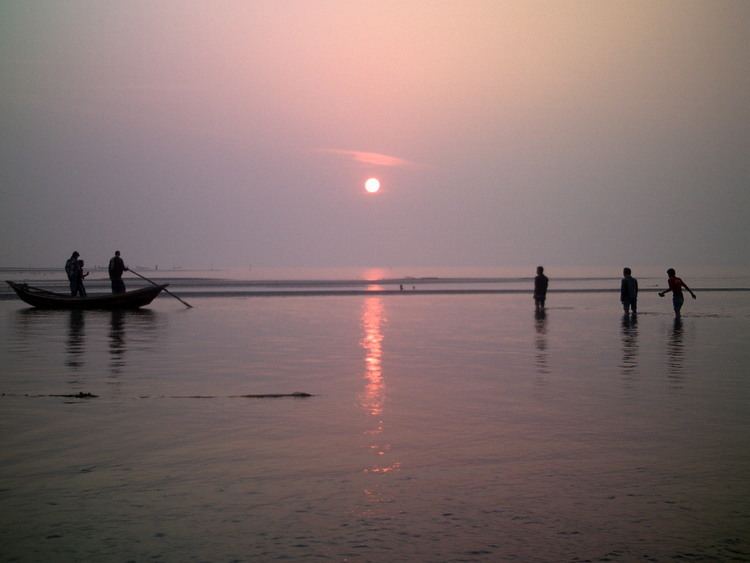Time zone BST (UTC+6) | Local time Saturday 10:41 PM | |
 | ||
Weather 24°C, Wind S at 11 km/h, 89% Humidity | ||
Kuakata (Bengali: কুয়াকাটা) is a town known for its panoramic sea beach. It is located in south-eastern Bangladesh, and is the number two tourist destination in the country. Kuakata beach is a sandy expanse 18 kilometres (11 mi) long and 3 kilometres (1.9 mi) wide. From the beach one can have an unobstructed view of both sunrise and sunset over the Bay of Bengal.
Contents
Map of Kuakata, Bangladesh
Etymology
The name Kuakata originated from the word 'Kua'-the Bengali word for "Well" which was dug on the sea shore by the early Rakhine settlers in quest of collecting drinking water, who landed on Kuakata coast in the eighteenth century after being expelled from Arakan (Myanmar) by the Mughals. Afterwards, it has become a tradition of digging Well in the neighbourhoods of Rakhaine tribes for water.
Geography
Kuakata is located in Kalapara Upazila, Patuakhali District. It is about 320 kilometres (200 mi) south of Dhaka, the capital, and about 70 kilometres (43 mi) from the district headquarters.
Demographics
According to the 2011 Bangladesh census, Kuakata had 2,065 households and a population of 9,077.
Culture
Kuakata is the place of pilgrimage for both Hindu and Buddhist communities. Innumerable devotees arrive here at the festival of 'Rush Purnima' and 'Maghi Purnima'. On these two occasions the pilgrims take holy bath at the bay and participate in the traditional fairs. One may also visit the 100 years old Buddhist Temple where the statue of Goutama Buddha and two wells of 200 years old are located.
Hotels at Kuakata:
Kuakata, although the second largest sea beach in Bangladesh, had been hitherto neglected, or less visited by a large number of tourists like we see in Cox's Bazar. This was primarily because the road condition and a lot of ferries used to keep the travellers disinterested to visit Kuakata up till now. But in the recent years, the government had improved the roads and highways which link the route to Kuakata. The road condition is currently in good condition and three ferries have been replaced by bridges after Patuakhali to Kuakata, thus the travel time and hassles at the ferry pontoons have been significantly reduced. Now only Padma bridge and Lebukhali remaining, Kuakata is becoming a major tourist attraction for both local and foreign tourists. As the tourism is starting to flow around the Kuakata's beauty, A handful of hotels have structured around the Kukata premises. The pioneer to spearhead the tourist attraction is Kuakata Grand Hotel. This is a fine five star standard boutique hotel and resort at Kuakata giving top class security and finest hotel services to both local and foreign tourists. Following Kuakata Grand Hotel other high net worth investors are eyeing Kuakata as a major hotel and resort attraction. There are a few budget hotels at Kuakata too. But for discerning clients, by far; Kuakata Grand Hotel, Kuakakata Guest House stands out with top class services and amenities.Hotel webpage.
Beach
Kuakata offers a full view of the sunrise and sunset from the same white sandy beach in the water of the Bay of Bengal. Locally known as Shagor Kannya (Daughter of ocean), the long strip of dark, marbled sand stretches for about 18 kilometres (11 mi). The long and wide beach at Kuakata has a typical natural setting. This sandy beach has gentle slopes into the Bay of Bengal. Kuakata is also a sanctuary for migratory winter birds.
On the eastern end of the beach is Gongamati Reserved Forest, an evergreen mangrove forest and snippet of the original Kuakata. When the Rakhines settled in the area in 1784, Kuakata was part of the larger Sundarbans forest. However, the Sundarbans is now at a distance of one-hour by speed boat. As a mangrove forest, Gongamati, like the Sundarbans, offers some protection against tidal surges, however it too is being threatened by logging and deforestation. The best way to reach the forest is by foot or bike along the beach, where a flock of flag flying fishing boats can be seen trawling the coast. Choosing to visit Gangamati in the late afternoon is a perfect time to watch the sun cast shadows on the abstract exposed mangrove roots.
On 13 September 2007 government had announced a red alert in Kuakata as caution for a possible Tsunami.
